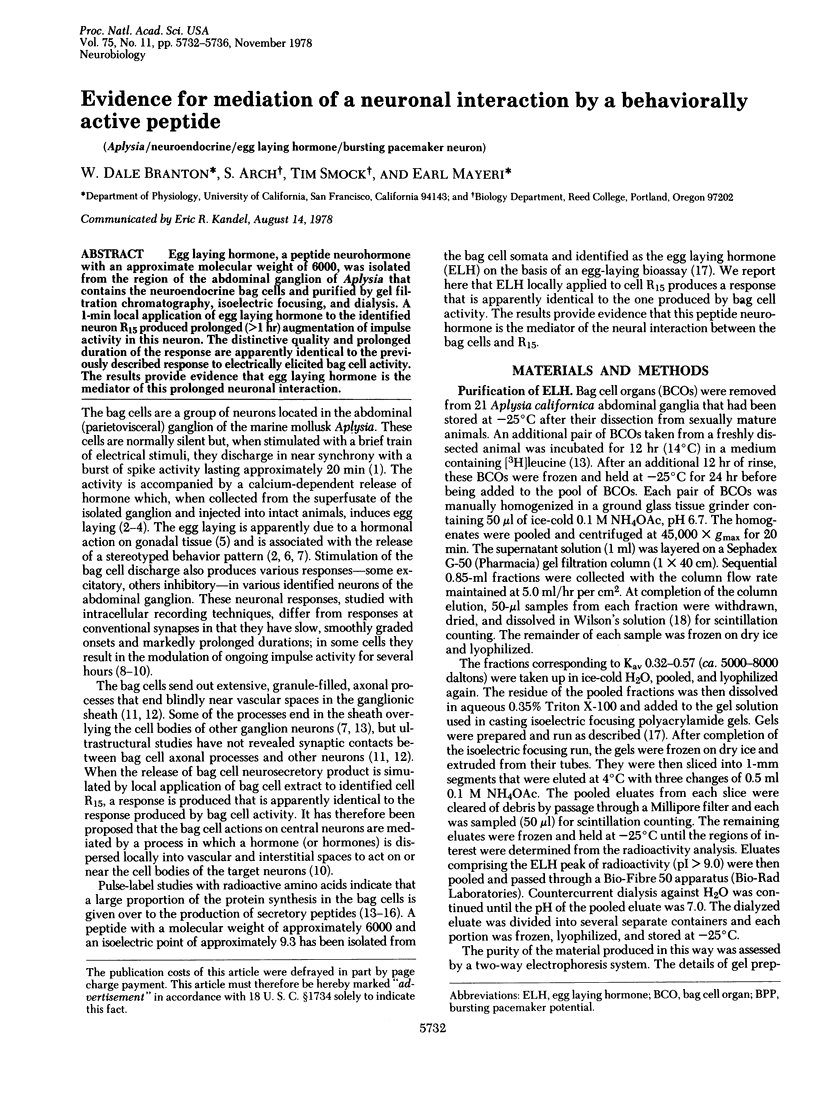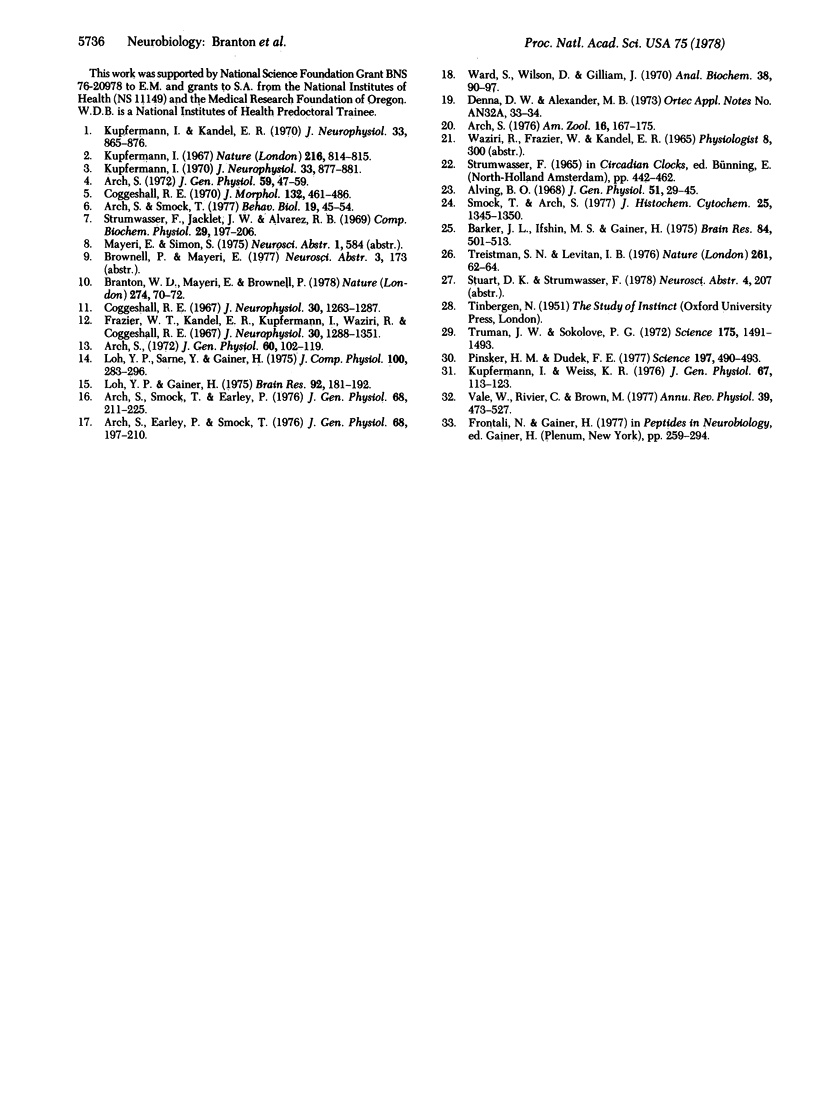Abstract
Egg laying hormone, a peptide neurohormone with an approximate molecular weight of 6000, was isolated from the region of the abdominal ganglion of Aplysia that contains the neuroendocrine bag cells and purified by gel filtration chromatography, isoelectric focusing, and dialysis. A 1-min local application of egg laying hormone to the identified neuron R15 produced prolonged (greater than 1 hr) augmentation of impulse activity in this neuron. The distinctive quality and prolonged duration of the response are apparently identical to the previously described response to electrically elicited bag cell activity. The results provide evidence that egg laying hormone is the mediator of this prolonged neuronal interaction.
Full text
PDF




Selected References
These references are in PubMed. This may not be the complete list of references from this article.
- Alving B. O. Spontaneous activity in isolated somata of Aplysia pacemaker naurons. J Gen Physiol. 1968 Jan;51(1):29–45. doi: 10.1085/jgp.51.1.29. [DOI] [PMC free article] [PubMed] [Google Scholar]
- Arch S. Biosynthesis of the egg-laying hormone (ELH) in the bag cell neurons of Aplysia californica. J Gen Physiol. 1972 Jul;60(1):102–119. doi: 10.1085/jgp.60.1.102. [DOI] [PMC free article] [PubMed] [Google Scholar]
- Arch S., Earley P., Smock T. Biochemical isolation and physiological identification of the egg-laying hormone in Aplysia californica. J Gen Physiol. 1976 Aug;68(2):197–210. doi: 10.1085/jgp.68.2.197. [DOI] [PMC free article] [PubMed] [Google Scholar]
- Arch S. Polypeptide secretion from the isolated parietovisceral ganglion of Aplysia californica. J Gen Physiol. 1972 Jan;59(1):47–59. doi: 10.1085/jgp.59.1.47. [DOI] [PMC free article] [PubMed] [Google Scholar]
- Arch S., Smock T., Earley P. Precursor and product processing in the bag cell neurons of Aplysia californica. J Gen Physiol. 1976 Aug;68(2):211–225. doi: 10.1085/jgp.68.2.211. [DOI] [PMC free article] [PubMed] [Google Scholar]
- Barker J. L., Ifshin M. S., Gainer N. Studies on bursting pacemaker potential activity in molluscan neurons. III. Effects of hormones. Brain Res. 1975 Feb 14;84(3):501–513. doi: 10.1016/0006-8993(75)90768-4. [DOI] [PubMed] [Google Scholar]
- Branton W. D., Mayeri E., Brownell P., Simon S. B. Evidence for local hormonal communication between neurones in Aplysia. Nature. 1978 Jul 6;274(5666):70–72. doi: 10.1038/274070a0. [DOI] [PubMed] [Google Scholar]
- Coggeshall R. E. A cytologic analysis of the bag cell control of egg laying in Aplysia. J Morphol. 1970 Dec;132(4):461–485. doi: 10.1002/jmor.1051320407. [DOI] [PubMed] [Google Scholar]
- Coggeshall R. E. A light and electron microscope study of the abdominal ganglion of Aplysia californica. J Neurophysiol. 1967 Nov;30(6):1263–1287. doi: 10.1152/jn.1967.30.6.1263. [DOI] [PubMed] [Google Scholar]
- Kupfermann I., Kandel E. R. Electrophysiological properties and functional interconnections of two symmetrical neurosecretory clusters (bag cells) in abdominal ganglion of Aplysia. J Neurophysiol. 1970 Nov;33(6):865–876. doi: 10.1152/jn.1970.33.6.865. [DOI] [PubMed] [Google Scholar]
- Kupfermann I. Stimulation of egg laying by extracts of neuroendocrine cells (bag cells) of abdominal ganglion of Aplysia. J Neurophysiol. 1970 Nov;33(6):877–881. doi: 10.1152/jn.1970.33.6.877. [DOI] [PubMed] [Google Scholar]
- Kupfermann I. Stimulation of egg laying: possible neuroendocrine function of bag cells of abdominal ganglion of Aplysia californica. Nature. 1967 Nov 25;216(5117):814–815. doi: 10.1038/216814a0. [DOI] [PubMed] [Google Scholar]
- Kupfermann I., Weiss K. Water regulation by a presumptive hormone contained in identified neurosecretory cell R15 of Aplysia. J Gen Physiol. 1976 Jan;67(1):113–123. doi: 10.1085/jgp.67.1.113. [DOI] [PMC free article] [PubMed] [Google Scholar]
- Loh Y. P., Gainer H. Low molecular weight specific proteins in identified molluscan neurons. I. Synthesis and storage. Brain Res. 1975 Jul 11;92(2):181–192. doi: 10.1016/0006-8993(75)90268-1. [DOI] [PubMed] [Google Scholar]
- Pinsker H. M., Dudek F. E. Bag cell control of egg laying in freely behaving aplysia. Science. 1977 Jul 29;197(4302):490–493. doi: 10.1126/science.197.4302.490. [DOI] [PubMed] [Google Scholar]
- Smock T., Arch S. A cytochemical study of the bag cell organs of Aplysia californica. J Histochem Cytochem. 1977 Dec;25(12):1345–1350. doi: 10.1177/25.12.72771. [DOI] [PubMed] [Google Scholar]
- Treistman S. N., Levitan I. B. Alteration of electrical activity in molluscan neurones by cyclic nucleotides and peptide factors. Nature. 1976 May 6;261(5555):62–64. doi: 10.1038/261062a0. [DOI] [PubMed] [Google Scholar]
- Truman J. W., Sokolove P. G. Silk moth eclosion: hormonal triggering of a centrally programmed pattern of behavior. Science. 1972 Mar 31;175(4029):1491–1493. doi: 10.1126/science.175.4029.1491. [DOI] [PubMed] [Google Scholar]
- Vale W., Rivier C., Brown M. Regulatory peptides of the hypothalamus. Annu Rev Physiol. 1977;39:473–527. doi: 10.1146/annurev.ph.39.030177.002353. [DOI] [PubMed] [Google Scholar]
- Ward S., Wilson D. L., Gilliam J. J. Methods for fractionation and scintillation counting of radioisotope-labeled polyacrylamide gels. Anal Biochem. 1970 Nov;38(1):90–97. doi: 10.1016/0003-2697(70)90158-2. [DOI] [PubMed] [Google Scholar]


